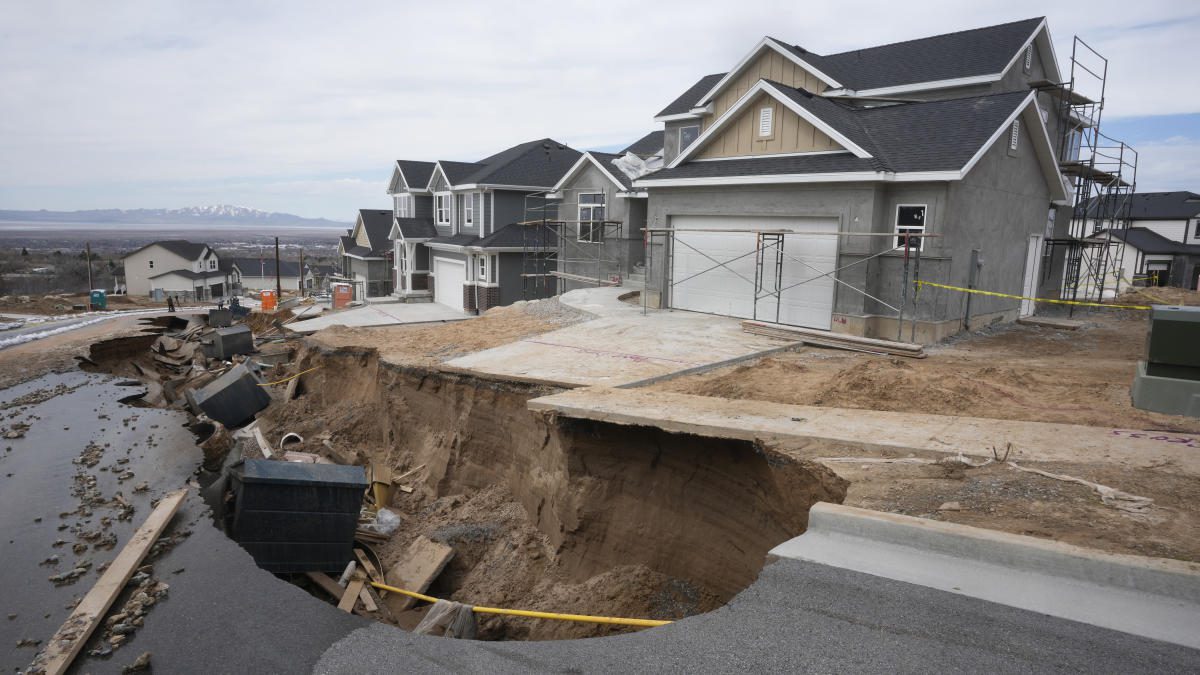Global Courant 2023-04-14 02:08:32
FLAGSTAFF, Ariz. (AP) — A rapidly melting snow in the spring after an unusually wet winter is causing flooding from the Southwest to the Rockies, forcing residents there and in the Upper Midwest to evacuate or stock up on sandbags amid fast-flowing creeks and rivers.
In Flagstaff, Arizona, neighbors on a street have been working side-by-side with shovels since Tuesday to prevent flooding from their homes.
Three creek ponds installed last year helped at first, the city’s emergency services said. But water has flooded the shoulder of a local highway and several roads and sidewalks have been closed. Even parts of city paths are under water.
Officials call it an unprecedented amount of water, something that was impossible to plan for.
“It would be nice to have an exact model of what we need to do. But we’re not doing that,” Flagstaff Vice Mayor Austin Aslan told the Arizona Daily Sun on Wednesday. “We don’t know what the next fire will look like, or where that scar will be. There are small differences that lead the water to one neighborhood or another.”
Sandoval County in north central New Mexico has issued a declaration of emergency following severe flooding in communities near the Jemez River. The river was 7 feet high on Thursday afternoon, according to the U.S. Geological Survey. Residents of the village of Jemez Pueblo, known for its mineral hot springs, were collecting sandbags as a precaution. The police chief there estimated that a dozen homes and other buildings along the river could be at risk.
The flood also led to the overflow of a wastewater treatment plant, which brought recycled water into the Jemez River. The US Forest Service is warning the public not to fish or drink water south of the plant.
In Salt Lake City, Mayor Erin Mendenhall signed an emergency order late Wednesday to help residents whose homes were threatened by flooding in the southeastern part of the city. Rapidly melting snow in nearby mountains caused water to rush through a nearby stream, leading to the voluntary evacuation of about 100 homes.
Story continues
The water receded as cooler weather moved into the area. Still, multiple mudslides were reported on canyon roads, including one that forced the temporary closure of Interstate 80 southeast of the city early Thursday.
On Wednesday, local officials north of Salt Lake City issued evacuation orders for at least 20 homes in Kaysville, where flooding caused a large gash that damaged a street, sidewalks and driveways in a substructure that was under construction.
Meanwhile, heavy snow and high temperatures expected to reach 60 degrees Thursday caused flooding in northwestern Colorado, where transportation officials closed Highway 40 between Craig and Steamboat Springs, a popular ski resort that has received more than 400 inches (1,016 centimeters) of snow this winter .
Flooding in the small mountain town of Hayden forced the closure of schools for the day, and Thursday afternoon saw a chance of rain in the area before turning to snow overnight. The Colorado Department of Transportation posted photos online showing Dry Creek flowing over its banks near a bridge there, as well as floodwaters threatening several parked recreational vehicles.
The National Weather Service issued a flood advisory through Saturday afternoon, warning that some roads could become impassable and urging motorists not to drive through flooded river crossings.
However, there were no reports of major damage in Utah or Colorado on Thursday.
As a rapidly melting snow and possible showers in April fuel fears of severe flooding in the Northern Plains, state officials are announcing plans for flood control. Residents have collected thousands – if not hundreds of thousands – of sandbags to fight flooding themselves.
The Red River Valley, which includes Fargo in North Dakota and Moorhead in Minnesota, faces flood threats as warm weather melts snow left over from one of the snowiest winters on record in the two states. Any significant rainfall could determine the size of the flood crest, Moorhead city engineer Bob Zimmerman told Minnesota Public Radio.
Minnesota Democratic Governor Tim Walz said at a news conference Thursday that the state is ready to move funds “in a very efficient, effective way” in response to the flooding.
He added that warmer temperatures and rising water levels due to climate change have contributed to the state’s months-long preparation for the spring flood season.
Local, state and federal public safety and emergency management partners have stepped up monitoring and preparedness efforts, according to the state’s Department of Public Security.
North Dakota Governor Doug Burgum has declared a statewide state of emergency for spring flooding and has made the National Guard available to help fight the flooding in the coming weeks, the Bismarck Tribune reported. The city of Bismarck opened sites for residents to fill their own sandbags.
In northern Montana, the Milk River would rise to its highest level in more than a decade and flood some rural areas.
Riverside emergency services in Glasgow patrolled the levee protecting the city of about 3,200 people to make sure it held, Valley County Disaster and Emergency Services Coordinator Rick Seiler said. Shelters were arranged in case low-lying areas needed to be evacuated.
The National Weather Service said the flooding would continue for the next week.
Heavy rain fell in the region on Thursday, as snow continued to pile up at higher elevations, Seiler said.
___
Associated Press writers Trisha Ahmed in Minneapolis, Matthew Brown in Billings, Montana, and Thomas Peipert in Denver contributed to this report.








